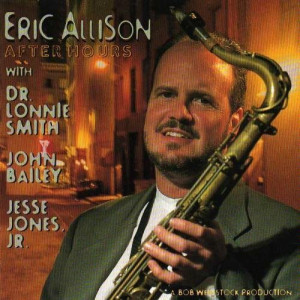Published on Apr 18, 1998
Although I don’t listen to a lot of jazz, I have been trying to
expand my knowledge of this musical form. It’s not that I don’t
like it – the little I have heard, I love jazz. It’s just that I’ve
been immersed in rock for so long that my “random pulls” out of the
Pierce Memorial Archives (bring me the head of Bill Wirtz on a
platter) are almost always exclusively rock.
But what I have discovered is this: I like my jazz crunchy. The
more uptempo the mood, the better – if I’m not tapping my foot to
it or bopping my head to the beat, odds are I’m not happy.
Eric Allison, then, is an enigma to me. On his second CD
After Hours, Allison shows how comfortable he is with the
uptempo numbers. But Allison also overachieves a bit – he tries to
prove that he’s a capable musician in many different flavors of
jazz. Listening to this disc is enjoyable, no doubt about that –
but when I go to Baskin-Robbins, I don’t want to taste all 31
flavors.
To say that Allison is the “leader” of this combo is a slight
misnomer. Sure, he’s usually the one upfront playing tenor or alto
saxophone (and, on one occasion each, flute and clarinet). But his
fellow players are just as equally important to the overall feel of
each piece as Allison is – and without even one of them in the mix,
the whole picture would suffer. Dr. Lonnie Smith’s piano work is
astounding, though I can’t say I was very impressed with his two
outings on the Hammond B-3. Bassist Dennis Marks and drummer Danny
Burger each have to wait some time for their solo leads, but it’s
well worth the wait for both of them. And I couldn’t begin to say
enough about the trumpet work of John Bailey – I wouldn’t have
minded hearing him on more than the five tracks he plays on. (Also
playing on the disc are alto saxophonist Jesse Jones, Jr. and
baritone saxophonist Turk Mauro.)
Things start off well enough with “Midnight Groove,” a track
which had my foot working overtime keeping the beat. But the pure
“jazz” feel of the disc is broken with the cover of Avery Parrish’s
“After Hours,” a track that sounds more bluesy than it does jazz.
(For that matter, the more I listen to artists like Thelonious
Monk, the more I hear a lot of blues in their jazz
performances.)
The jump around from style to style continues on almost every
single track, from the soul leanings of “‘Round About Dawn” to the
Rashann Roland Kirk influences on “Tip-Toein'”, from the rock feel
of “No Cover” to the gospel tinges of “Sittin’ In” to the New
Orleans Cajun flavor of “Delta Joy,” it occasionally gets tiring to
have to keep switching genres. This isn’t to say that some of these
performances aren’t worthy of your attention. The more I listened
to “Sittin’ In,” the more I liked it, while “No Cover” and
“Straight Up” gave me exactly what I wanted – upbeat, fastre-tempo
jazz.
But after a few listens to
After Hours, you do find yourself admitting that the mix of
styles works – just not as well as if Allison and crew had maybe
cut down to two or three genres and played more songs in those
veins. (And no matter how hard I try, I just can’t get into “Delta
Joy”. Maybe I need to spend some time sipping in the New Orleans
ambiance – wonder if the missus is up for the car trip.)
One note about Allison’s multi-instrument performance. As good
as the sax work is, two words: more flute! “Tip-Toein'” brought
back memories of Jethro Tull’s early days, and I found myself
constantly going back to this track. ‘Nuff said.
Allison’s talents, as well as those of his fellow bandmates, are
above reproach. And
After Hours would have been a perfect showcase for their
talents had Allison settled on one or two particular styles,
instead of trying to cram the history of jazz’s evolution in 75
minutes. Still, this is a disc that’s worth adding to your
collection.
